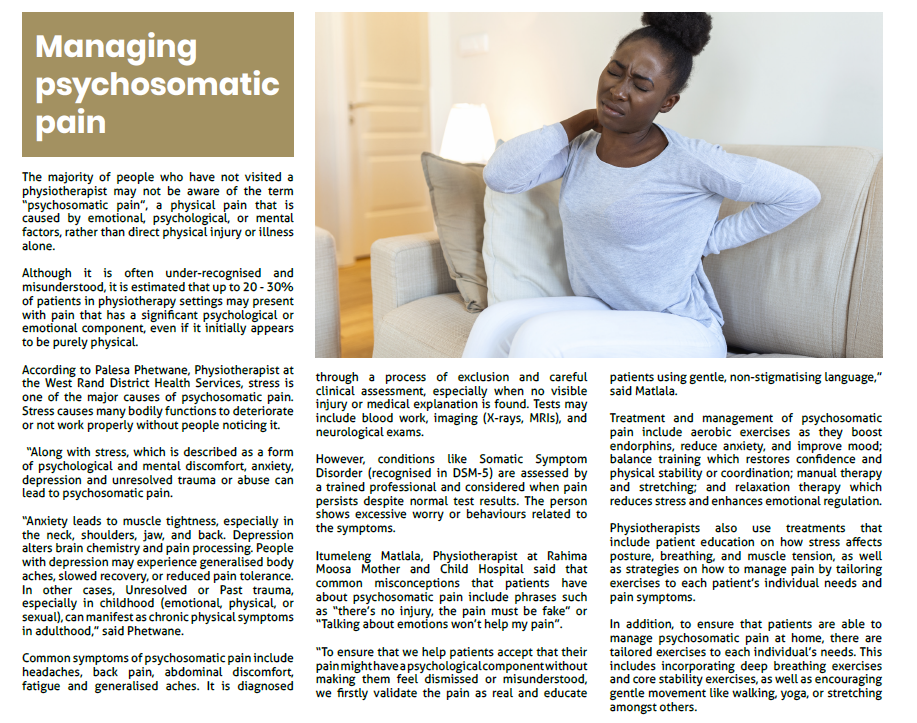How Stress and Trauma Cause Real Physical Pain – And What You Can Do

Table of contents
What Happens in the Body: The Mind-Body Connection
The body’s natural stress response, commonly known as “fight or flight,” involves releasing stress hormones such as cortisol and adrenaline. These prepare the body to face or escape danger by increasing alertness and muscle tension. However, when stress or trauma becomes chronic, this system remains overactive, causing ongoing muscle tightness, inflammation, and heightened sensitivity to pain.

Trauma can disrupt the communication between the brain and body, leading to nervous system dysregulation. This dysfunction means the brain may amplify or even create pain signals without direct physical causes. This process explains why some people with trauma experience widespread, unexplained pain even after physical injuries heal.
ALSO READ: Gauteng Clinics Offer New Support for Stress-Related Pain
Understanding the Link Between Stress, Trauma, and Physical Pain
Stress and trauma don’t just affect our mental health, they can manifest as real physical pain in the body. When someone experiences trauma, such as abuse, loss, or a frightening event, the body reacts with strong emotional and physiological responses. These responses can alter how the nervous system processes pain signals, often producing sensations that feel as real and intense as pain from physical injury.
Scientific studies show up to 80% of people who suffer or witness trauma report chronic physical pain conditions like headaches, back pain, or fibromyalgia. This means that pain caused or amplified by psychological distress is common and significant.
The Physical Effects of Trauma
The physical effects of trauma on the body arise from complex mind-body interactions where emotional distress alters bodily functions, often producing real and lasting physical pain.
Key effects include:
- Heightened Stress Response and Hormonal Changes: Trauma triggers the body’s “fight or flight” response, releasing stress hormones like cortisol and adrenaline. When this stress system remains chronically activated, it leads to persistent muscle tension, inflammation, and increased sensitivity to pain signals.
- Nervous System Dysregulation: Trauma disrupts normal communication between the brain and the body, causing the nervous system to malfunction. This can amplify or generate pain sensations even without physical injury, contributing to conditions such as chronic headaches, back pain, and fibromyalgia.
- Psychosomatic Symptoms: Physical symptoms with no clear medical cause often appear, including muscle stiffness, abdominal pain, chest tightness, and joint pain. These symptoms are genuine bodily distress caused by psychological trauma rather than imagined.
- Increased Risk of Chronic Pain Syndromes: Trauma survivors have a higher prevalence of chronic pain disorders like fibromyalgia and chronic fatigue syndrome, often linked with post-traumatic stress disorder (PTSD). PTSD symptoms such as hypervigilance and anxiety further maintain muscle tension and pain.
- Inflammation and Immune System Impact: Chronic stress and trauma may increase inflammation in the body and alter immune responses, worsening physical pain and health outcomes.
- Sleep Disruption and Fatigue: Trauma-related stress can cause poor sleep quality and nightmares, which exacerbate physical pain and reduce the body’s capacity to recover.
- Psychological and Emotional Consequences: Physical pain from trauma impacts mental health, potentially causing depression, anxiety, and social isolation, which in turn can worsen pain perception and quality of life.
Trauma causes real physical effects through persistent stress, nervous system changes, and inflammatory processes. These interconnected effects make trauma-related pain challenging but highlight the necessity of integrated treatment addressing both mind and body.
Psychosomatic and Chronic Pain from Trauma
Psychosomatic pain refers to physical discomfort caused by psychological factors rather than injury. People affected might have symptoms like headaches, joint stiffness, abdominal pain, or chest tightness with no clear medical explanation. These symptoms are not “imaginary,” they reflect genuine bodily distress stemming from emotional pain.
Trauma also increases the risk of chronic pain syndromes such as fibromyalgia and chronic fatigue syndrome, which often coexist with post-traumatic stress disorder (PTSD). PTSD symptoms: like hypervigilance, anxiety, and muscle tension, further worsen pain by keeping muscles tense and stress hormones elevated.
Why This Pain Matters
The physical pain linked to stress and trauma severely impacts day-to-day functioning. It reduces quality of life, creates emotional distress, and may lead individuals to seek high doses of pain medication without addressing underlying causes. Recognising the root in trauma is crucial for effective treatment.
People with trauma-related pain often feel misunderstood or dismissed, which can worsen their suffering. Awareness that trauma can cause real physical symptoms helps victims access appropriate care that treats both body and mind.
What You Can Do: Managing and Healing Psychosomatic Pain
1. Seek Integrated Healthcare:
Treatment that combines mental health support and physical care yields the best results. Psychotherapy, especially Cognitive Behavioural Therapy (CBT), can address emotional trauma and help regulate pain perception.
2. Practice Stress Reduction:
Techniques like mindfulness, meditation, yoga, and breathing exercises reduce muscle tension and balance the nervous system. These help lower stress hormones and ease pain sensations.
3. Use Physical Therapies:
Physiotherapy, massage, and gentle exercise help relieve muscular tightness and improve mobility, complementing psychological treatments.
4. Medication and Medical Support:
While pain medication might be necessary, treating trauma symptoms with antidepressants or anxiolytics can reduce pain intensity. Always consult a healthcare professional for personalised care.
5. Build Support Networks:
Connection with supportive friends, family, or support groups can alleviate isolation and improve emotional resilience.

When to Seek Help
If you experience persistent or unexplained physical pain alongside emotional distress, consider speaking with a healthcare provider. Early intervention can prevent chronic pain from worsening and improve both mental and physical health.
Stress and trauma reshape how your brain and body experience pain. Understanding this connection empowers you to seek effective care and reclaim your wellbeing.
Health & Wellness
Understanding the profound impact stress and trauma have on physical pain is crucial for effective healing and wellbeing. Psychosomatic pain is real and can deeply affect daily life, but with awareness and the right support, it is manageable. By seeking integrated healthcare, practising stress reduction, using physical therapies, and building strong support networks, individuals can begin to reclaim their health. Early recognition and compassionate treatment not only ease pain but also restore balance between mind and body. Remember, addressing both emotional and physical aspects is key to overcoming trauma-related pain and improving quality of life.
Feeling overwhelmed? Discover 10 Effective Ways to Manage Stress in 2025. Your peace of mind starts here.




